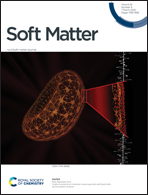From dynamic self-organization to avalanching instabilities in soft-granular threads†
Abstract
We study the dynamics of threads of monodisperse droplets, including droplet chains and multi-chains, in which the droplets are interconnected by capillary bridges of another immiscible liquid phase. This system represents wet soft-granular matter – a class of granular materials in which the grains are soft and wetted by thin fluid films—with other examples including wet granular hydrogels or foams. In contrast to wet granular matter with rigid grains (e.g., wet sand), studied previously, the deformability of the grains raises the number of available metastable states and facilitates rearrangements which allow for reorganization and self-assembly of the system under external drive, e.g., applied via viscous forces. We use a co-flow configuration to generate a variety of unique low-dimensional regular granular patterns, intermediate between 1D and 2D, ranging from linear chains and chains with periodically occurring folds to multi-chains and segmented structures including chains of finite length. In particular, we observe that the partially folded chains self-organize via limit cycle of displacements and rearrangements occurring at a frequency self-adapted to the rate of build-up of compressive strain in the chain induced by the viscous forces. Upon weakening of the capillary arrest of the droplets, we observe spontaneous fluidization of the quasi-solid structures and avalanches of rearrangements. We identify two types of fluidization-induced instabilities and rationalize them in terms of a competition between advection and propagation. While we use aqueous droplets as the grains we demonstrate that the reported mechanisms of adaptive self-assembly apply to other types of soft granular systems including foams and microgels. We discuss possible application of the reported quasi-1D compartmentalized structures in tissue engineering, bioprinting and materials science.



 Please wait while we load your content...
Please wait while we load your content...